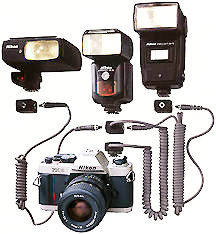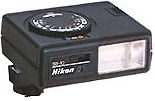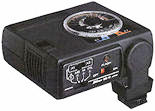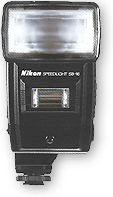Flash Photography
Nikon recommended in the manual some Nikon Speedlights with the FM-10. But since the market is predominated by autofocus cameras, naturally flash units designed are mainly autofocus driven. However, those come with a built-in sensor for automatic flash control like the current SB-26, SB-27, SB-28 and SB-16B are the few options you may also used with your FM-10.
 SB-27 |
 SB-28 SB-28 |
However, since flash capability with the camera is very restrictive - as the FM-10 has only a hot shoe contact and does not even provide with a PC terminal, investing into one of these flash units is just a waste of money. I wish to remind you that speedlights like those mentioned above could easily cost you another camera like the FM-10. |
Anyway, if your intention is to invest into an autofocus flash now for possible future migration to autofocus model or the FM-10 is only used as a mechanical backup to your electronic autofocus SLRs, then it is fine. Otherwise, you might as well give the flash a little justice and buy a AF Nikon SLR camera, after all, Nikon still leads in the field of metering and flash exposure control and most of the AF flash has amazing features to work with all the electronic gadgets in an modern AF SLR camera.
(More info: Nikon SB-1 to SB-21
Speedlight/Flash Units)
Well, you need not have to buy any of those flash even if you specifically want
a Nikon flash unit. Older speedlights model such as SB-10, SB-15 etc. can also be
used with the camera in either auto or manual mode. If the shop assistant keep trying
to tell you all the goodies that the new AF flash can provide you, just ignore him
- because the FM-10 nor the FE-10 can take any advantage any of those features provide
by any of those speedlights Well, among the few modern flash units mentioned just
now, if you want high power combine with fill flash, stroboscopic effects and extra
flexibility of tilt and bounce capabilities (but not a good flash if mobility is
a consideration), provided if you can afford one, the SB-16B can be a good option.
Anyway, if you rarely work with flash, just look into the used market for a used
SB-10 or even a better specification Nikon SB-15. The
FM-10 has no TTL OTF flash exposure control method commonly found in many modern
SLR cameras (Sorry, FE-10 is not provided as well). Thus, you can only use FM-10
either in manual flash mode or in automatic flash. Well, both method would require
a photographer to have some rough idea how flash photography works.
Manual Flash It
is quite good to memorize the 'Guide Number' of your flash unit. Guide Numbers are
just measurement of its relative light output to rate how powerful is a flash unit.
Although you will not need to use them with automatic flash units, it is still a
good idea to be familiar with the concept of how guide number works. Generally, all
stated guide numbers are to be measured at ISO 100 either in feet or meters. Most
flash units have a stated guide number in their instruction booklets. If your flash
states its guide number as a metric, just convert to an approximate one in feet by
multiplying by 3.3, and conversely, to convert a guide number in feet to meters you
can divide by 3.3. When you use the flash in non-direct method like bounce flash
or adding any adapter to widen the flash coverage, the guide number of the flash
will be diluting accordingly, in such cases, you have to open up a stop of two to
compensate for the loss of light intensity. Most of the time you might not required
to calculate aperture used for a given distance, because most flash has either a
graph or calculator dial to help you obtain the recommended f-number used. Just make
sure the calculator is based on the correct film speed for the film type in used.
The simple formula for guide number is: Guide Number = Lens Aperture Number x Distance to Subject |
 |
Automatic Electronic Flash |
| Multi flash set up ? Possible but it is not logical to invest into such accessories as the FM-10 has not provided with the TTL flash exposure control feature. However, if you still persist to do so, only automatic flash will be available, manual flash for such setup can be very complicated a for proper exposure. |
If you wish to use automatic flash for fill-flash operation, you will probably find that following the above procedure produces artificial looking images because the flash-fill light will be as bright as the ambient light. To solve this problem, close down the camera lens one stop more than indicated on the flash. For example, if the flash indicates f/5.6, then set the lens for f/8 and choose a corresponding shutter speed for the ambient light exposure. (Just make certain it's not faster than the sync speed.) The photograph is properly exposed by the ambient light with a one-stop underexposure from the flash so the fill light is subtle and not overpowering.
 SB-10
SB-10  SB-15
SB-15
Quick reference
guide on Speedlight
SB-15's
Specifications
Light output
control:
Silicon thyristor-controller rectifier and series circuitry TTL automatic flash output
control with Nikon FA, Nikon FE-2, Nikon FG or any AF bodies, except retaining the
AF function when work with those bodies. Automatic control (non-TTL) and manual:
possible with other Nikon SLRs.
Bounce flash: Possible by rotating the
flash head; up to 90° vertically upper direction
Guide number:
25 (ASA/ISO 100 and meters) at full output, 7 in MD (motor-drive) mode
Recycling
time: Approx.
8 sec. with alkaline-manganese batteries at full output
No. of flashes: Approx. 160 with alkaline-manganese
batteries at full output; 60 with the manganese batteries at full output
Angle of
flash coverage:
Covers picture angles of 35mm, 28mm (with SW-6) lenses Horizontal 56° (67°
when using wide-adapter SW-6) Vertical 40° (48° when using wide-adapter SW-6)
Power source: Four 1.5VAA-type penlight
batteries
Dimensions: Approx. 101mm(W) x4 2.5mm(H)
x 90mm(D) (excluding mounting foot)
Weight: Approx. 270g (excluding
batteries)
Quick reference guide on Speedlight
SB-16B's
Specifications
 |
SB-16A is the only ISO shoe mount flash that has a small fill in flash. and it is fully compatible with all Nikon SLRs. It is actually a SB-16B with Nikon F3's mounting foot; while the SB-17 is the Nikon F3's dedicated version of the SB-15. Spec sheets for both versions are the identical. •SB-16A (with Flash Unit Coupler AS-8) offers TTL automatic control with F3 series; •SB-16B (with Flash Unit Coupler AS-9) offers TTL automatic control with FS, F90X, F4 series, F70, F-601, F5O or PRONEA 600i |
Specifications
Light output control:
Silicon thyristor-controller rectifier and series circuitry; TTL automatic flash
output control with Nikon FA, Nikon FE2, Nikon FG or even any AF bodies (AF function
is not possible) when work with those bodies. Only auto and manual flash capability
with camera other than those mentioned.
Guide number: 32 (ASA/ISO 100 and meters)
at full output; 8 in MD (motor-drive) mode (32 with zoom head set at N (35mm); 19
at W1 (28mm), with Wide-Flash Adapter SW-7)
Recycling
time: Approx.
11 sec. with alkaline-manganese batteries at Manual full output
No. of flashes: Approx. 100 with alkaline-manganese
batteries at full output
Angle of
flash coverage:
Covers picture angles of 85mm, 50mm, 35mm, 28mm, 24mm (with Wide-Flash Adapter SW-7)
lenses by zooming main flash head
Film speed
range: ISO
25 to 1000 (25 to 400 with F3 series)
Power source: Four 1.5V LR6 (AA-type
alkaline) or 1.2V KR-AA (AA-type NiCd) batteries
Dimensions: Approx. Approx. 82mm(W)
x 144mm(H) x 100mm(D)
Weight: Approx. 445g (excluding
batteries)
Specifications on Nikon
SB-E or SB-9 Flash
Light output
control:
Automatic using silicon-controlled rectifier and series circuitry
Guide number: 17 (ASA/ISO 100 and meters)
Angle of
coverage:
56° horizontal, 40° vertical; covers angle of 35mm lens
Recycling
time: Up
to a maximum of approx. 9 sec. with a fresh set of batteries. Four 1.5V AAA-type alkaline-manganese batteries
(manganese batteries may be used)
Auto-flash
range: 0.6-6m
(2-20 ft)
 SB-9 SB-9 |
 SB-E SB-E |
Ready-light: Provided |
 |
What about third party speedlights ? Why not ? |
Other Nikon accessories:
There are many other Nikon SLR accessories available to expand your photographic
system with the FM-10. These include close-up equipment (close-up attachment lenses,
cable release, etc.) and a variety of
other system accessories including filters, cases etc..
| Previous | Next
| Some Personal Comments
| Back | to Index Page of FM-10
| Back
| to Main Index Page
of FM Series Models
Camera Instruction Manual (3
parts) | Other Issues relate to Nikon FM-10.
| Back | to Index Page of FM-10
| Back
| to Main Index
Page of FM Series Models
| Message Board | for
your favourite Nikon
FM Series SLR models
| Message
Board | for your Nikon
Optics in a shared environment
| Message Board | Specifically for Dispose or Looking for Nikon/Nikkor
Photographic Equipment
Standard
production Nikon FM Series models:-
Nikon FM | Nikon FM2 | Nikon FM2n | Nikon FM10 | Nikon FM3a |
Known
variants:-
Nikon
FM Gold
| Nikon
FM2/T
| Nikon
FM2N Tropical Set
| Nikon
FM2/T Limited Edition
| Nikon
FM2N LAPITA
|
Nion
FM2n Millennium 2000
Shared Resources: MD-11 | MD-12 | Focusing Screens | Titanium Shutter | Flash Units -SB-16 | SB-15 | SB-10 or other Options | Databack | Nikkor lens mount (related info)
Others:- Nikon AF-TTL Speedlights | SB-20 (1986) | SB-22 (1987) | SB-23 | SB-24 (1988) | SB-25 (1991/2) | SB-26 (1994) | SB-27(1997) | SB-28 (1997) | Nikon SB-29(s) (2000) | Nikon SB-30 (2003) | Nikon SB-600 (2004) | Nikon SB-800 (2003) Nikon AF-TTL Speedlight DX-Series: Nikon SB-28DX (1999) | SB-50DX (2001) | SB-80DX (2002)
Nikon
BC-flash Series |
Original
Nikon Speedlight
SB-2
| SB-3
| SB-4
| SB-5
| SB-6
| SB-7E
| SB-8E
| SB-9
| SB-E
| SB-10
SB-11
| SB-12 | SB-14 | SB-140 UV-IR| SB-15 | SB16A | SB-17 | SB-18, SB-19 | SB-21A (SB-29) Macro flash | Flash Accesories | SF-1
Pilot Lamp
Instruction
Manual: Nikon FM (HTML | PDF) | Nikon FM-10 (HTML) | Nikon FM2n's
User's Manual
available only in HTML format (6
parts) | Nikon
FM3A
(HTML)
| Nikon F | Nikon F2 | Nikon F3 | Nikon F4 | Nikon F5 | Nikon F6 | Nikkormat / Nikomat | Nikon FM | Nikon FE/ FA | Nikon EM/FG/FG20 | Nikon Digital SLRs | Nikon - Other models |
Nikon Auto Focus Nikkor lenses:- Main
Index Page
Nikon Manual Focus Nikkor lenses:- Fisheye-Nikkor Lenses - Circular | Full Frame |
Ultrawides Lenses - 13mm15mm18mm20mm | Wideangle Lenses - 24mm28mm35mm | Standard Lenses - 45mm 50mm 58mm | Telephoto
Lenses - 85mm105mm135mm180mm & 200mm | Super-Telephoto Lenses - 300mm 400mm 500mm 600mm 800mm 1200mm |
 Index Page |
Special
Application lenses: Micro-Nikkor Lenses - 50mm~55mm -60mm 85mm -105mm 200mm Micro-Zoom 70-180mm Perspective Control (PC) - 28mm 35mm PC-Micro 85mm Dedicated Lenses for Nikon F3AF: AF 80mm f/2.8 | AF 200mm f/3.5 EDIF Depth of Field Control (DC): 105mm 135mm Medical Nikkor: 120mm 200mm Reflex-Nikkor Lenses - 500mm 1000mm 2000mm Others: Noct Nikkor | OP-Nikkor | UV Nikkor 55mm 105mm | Focusing Units | Bellows-Nikkor 105mm 135mm Nikon Series E Lenses: 28mm35mm50mm100mm135mm | E-Series Zoom lenses: 36~72mm75~150mm70~210mm |
MF Zoom-Nikkor Lenses: 25~50mm | 28~45mm | 28~50mm | 28~85mm | 35~70mm | 36~72mm E | 35~85mm | 35~105mm | 35~135mm | 35~200mm | 43~86mm | 50~135mm | 50~300mm | 70~210mm E | 75~150mm E | 80~200mm | 85~250mm | 100~300mm | 180~600mm | 200~400mm | 200~600mm | 360~1200mm | 1200~1700mm
Tele-Converters: TC-1 | TC-2 | TC-200 | TC-201 | TC-300 | TC-301 | TC-14 | TC-14A | TC-14B | TC-14C | TC-14E | TC-16 | TC-16A | TC-20E
Recommended links to understand more technical details
related to the Nikkor F-mount and production Serial Number:
http://rick_oleson.tripod.com/index-153.html by: my
friend, Rick Oleson
http://www.zi.ku.dk/personal/lhhansen/photo/fmount.htm by: Hansen,
Lars Holst
http://www.mir.com.my/rb/photography/hardwares/nikonfmount/lens2.htm
http://www.photosynthesis.co.nz/nikon/serialno.html
W A R N I N G: The New G-SERIES Nikkor lenses have no aperture ring on the lens, they CANNOT ADJUST APERTURES with any of these manual focus Nikon FE series SLR camera models; please ignore some portion of the content contained herein this site where it relates.
|
Back | Main Index Page of Nikkor Resources
|
Back | Main Index Page of Pictorial
History of Nikon SLRs
| Message Board | for your Nikkor optics ("shared" because I do wish some of you to expose to other's perspective as well. Isn't it a sad sate to see photography has to be segmented into different camps from the use of various labels)
about this photographic web site
Home - Photography in Malaysia |
Credit: To all the good people who has contributed their own experience, resources or those who are kind enough granting us permission to use their images appeared in this site. Mr. MCLau®, who has helped to rewrite some of the content appeared this site. Chuck Hester® who has been helping me all along with the development of all these Nikon websites;LarsHolst Hansen, 'Hawkeye' who shares the same passion I have; Ms Rissa, Sales manager from Nikon Corporation Malaysia for granting permission to use some of the official content; TedWengelaar,Holland who has helped to provide many useful input relating to older Nikkor lenses; Some of the references on production serial numbers used in this site were extracted from Roland Vink's website; HiuraShinsaku from Nikomat Club Japan. t is also a site to remember a long lost friend on the Net. Note:certain content and images appeared in this site were either scanned from official marketing leaflets, brochures, sales manuals or publications published by Nikon over the years and/or contribution from surfers who claimed originality of their work for educational purposes. The creator of the site will not be responsible for may discrepancies arise from such dispute except rectifying them after verification."Nikon", "Nikkormat", "Nippon Kokagu KK" & "Nikkor" are registered tradename of Nikon Corporation Inc., Japan. Site made with an Apple IMac.